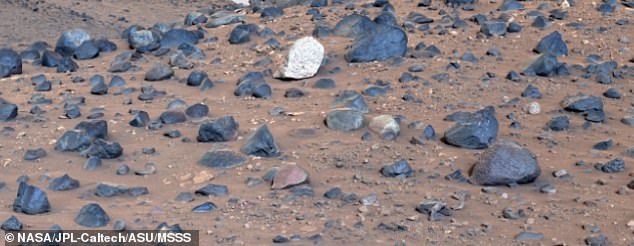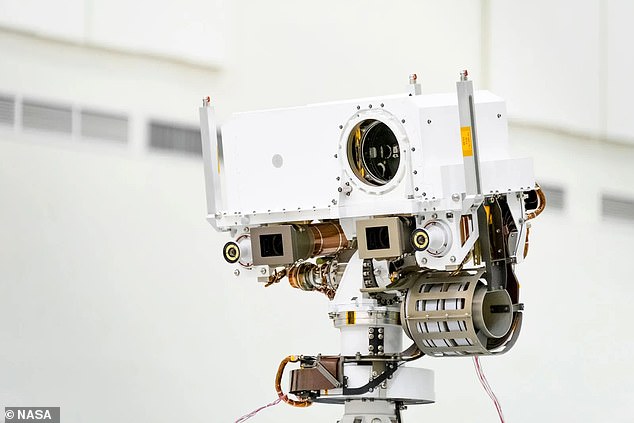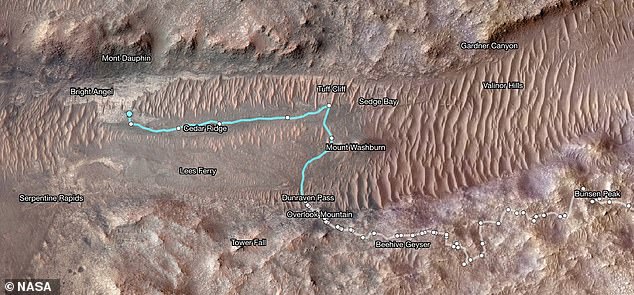NASA releases clearest view of Mars ever that shows blue rocks littering the Martian landscape
NASA has released the clearest image of Mars yet, showing beautiful blue rocks dotting the Martian landscape.
The images, captured by the Perseverance rover as it continues to explore the Red Planet, have also been revealed ‘first of its kind’ geological formation that rests atop the dried remains of an ancient lake bed.
DArk-blue, jagged boulders of volcanic basalt were seen surrounding the speckled white rock, which appeared to have a mineral composition unlike anything NASA has ever seen before on Mars.
The NASA team piloting the rover named this rocky field “Mount Washburn” in honor of a mountain in Yellowstone National Park.
Most of the blue-black rocks you see on the surface of Mars, such as those on ‘Mount Washburn’, are volcanic basalt (above). The rocks are similar to the volcanic rocks beneath Earth’s oceans
Perseverance – a remote-controlled mobile laboratory the size of a car – has been exploring the dusty basin of this asteroid impact site, the Jezero Crater, since February 2021.
Jezero once flowed with water some 3.7 billion years ago, with evidence of a ‘paleola lake’ and a long, lost river delta within the rim of this 45 kilometer diameter crater.
Fine-grained sand and mud of exactly the consistency known to preserve fossils on Earth were carried to Jezero via these rivers: fine clay where Perseverance had been sent to explore. NASA’s belief that this crater May have once supported extraterrestrial life.
“Every now and then you see something strange in the Martian landscape,” said a NASA planetary geologist Dr. Katie Stack Morgan from NASA’s Jet Propulsion Laboratory say it,’ and the team says, ‘Oh, let’s go there! ”
Most of the blue-black rocks you see on the surface of Mars, such as those on Mount Washburn, are volcanic basalt.
‘Mars consists mainly of rocks that resemble terrestrial basalts, called tholeiites,’ says planetologist and geophysicist Dr. G Jeffrey Taylor at the University of Hawaii, ‘which form most oceanic islands, mid-ocean ridges and the seafloor beneath sediments [on Earth].’
But the white, speckled rock that stood out in the middle of this basalt surprised NASA’s Perseverance team.

The white, speckled rock – now called ‘Atoko Point’ – stood out in the middle of this blue-black volcanic basalt, surprising NASA’s Perseverance team.
“This looked like the textbook definition [chasing] that bright, shiny thing,” said Dr. Stack Morgan, “because it was so bright and white.”
Perseverance took the photo with its Mastcam-Z, a three-dimensional set of cameras placed at human eye level on a 6-foot-tall mast on top of the rover.
Mastcam-Z offers a quality of 2 megapixels, ‘similar to that of a consumer digital camera’, according to the specifications of the US space agencies, which explains the clear image of this rock formation.
The camera’s 3D images offer a resolution of 0.0059 inches per pixel at close range and 0.3 inches per pixel at maximum zoom.
NASA named the new, arresting white rock, which measures about 20 inches wide and 12 inches high, “Atoko Point,” after a more than 8,000-foot cliff in the Grand Canyon.

Perseverance took the photo with its Mastcam-Z, a three-dimensional set of cameras placed at human eye level on a 6-foot-tall mast on top of the rover.

The path to ‘Atoko Point’ near ‘Bright Angel’ in the Jezero crater on Mars
But it was the full suite of chemical analysis and geological tools of the discovery robot, SuperCam, that helped determine what a unique discovery the ‘Atoko Point’ rock really was.
SuperCam’s two lasers and four spectrometers found enough of the mineral feldspar to confirm that this white rock was anorthosite, a type of rock that has long been theorized but never previously documented as occurring on Mars, noted Dr. Stack Morgan .
Like basalt, anorthosites are also volcanic rocks, but they are richer in silica compounds, suggesting that this ‘Atoko Point’ rock may have formed deeper underground than the rocks surrounding it.
Further examples of anorthosite could help determine whether ‘Atoko Point’ was dragged into the crater by ancient rivers or formed underground by lava, perhaps lifted up by the impact that created the Jezero Crater billions of years ago.
“Seeing a rock like Atoko Point is one of these clues that ‘Yes, we have anorthosites on Mars,'” Dr. Stack Morgan from NASA JPL. Mashable. “And this could be a sample of that lower crustal material.”
The NASA JPL researcher, the deputy project scientist on NASA’s Mars 2020 mission that launched Perseverance years ago, said she hopes more finds like the rock will reveal details about what’s now beneath the surface of Mars and how the planet formed .
“If we later see it in the context of other rocks, it could give us an idea of how Mars’ earliest crust formed.”
